One of the exotic bushes brought and cultivated in our country is an oleander. This plant is used both for greenhouses and winter gardens, and for decorating houses and offices. Despite its unusual appearance, the oleander does not require careful care, and its cultivation at home is limited only by simple rules that allow you to achieve the annual abundant flowering shown in the photo.
Before you purchase a flower, you should familiarize yourself with information on its cultivation, as well as know that the plant contains poison in its composition, which can harm young children and pets.
Content
Characteristics of common oleander and species diversity with names
Oleander is a bush with evergreen foliage and fragrant flowers, growing both in the streets, gardens, and in houses. The natural habitat of the plant is a country with a subtropical climate. Beautiful flowering thickets can be found on the shores of water bodies in Europe, China, North Africa, since it needs a lot of moisture.
The following characteristic features of the oleander can be distinguished:
- height, depending on the variety, is 1.5-3 meters;
- leaf color - dark green;
- branching stems of a brown hue;
- narrow leaves up to 3 cm wide are attached to the stem with short roots;
- the length of the foliage is 10-15 cm;
- flowers are large, five-petalled;
- inflorescence collected in a brush;
- color scale: white, pink, red, yellow;
- specific pronounced aroma during flowering.
In the climatic conditions of our country, the bush can be grown in the house, so that it year-round gladdened with greenery, and in the summer bloomed with bright colors. The oleander ordinary, which has different varieties, is best cultivated for indoor cultivation.
Features of plant varieties shown in the photo are as follows:
- Rigoletto has terry pink flowers, twisted petals in the center of the flower;
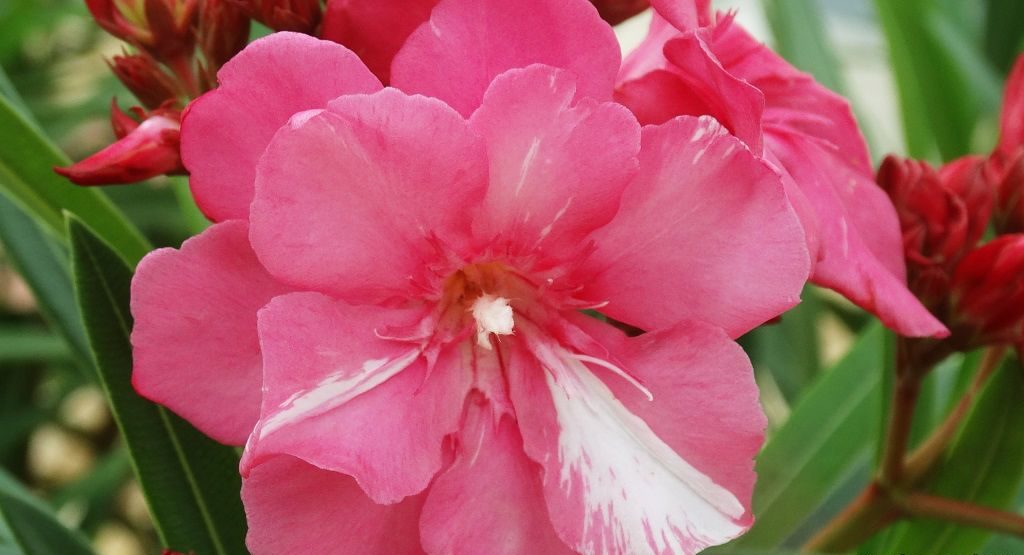
Rigoto - Petite Salmon - a dwarf plant with small peach flowers;
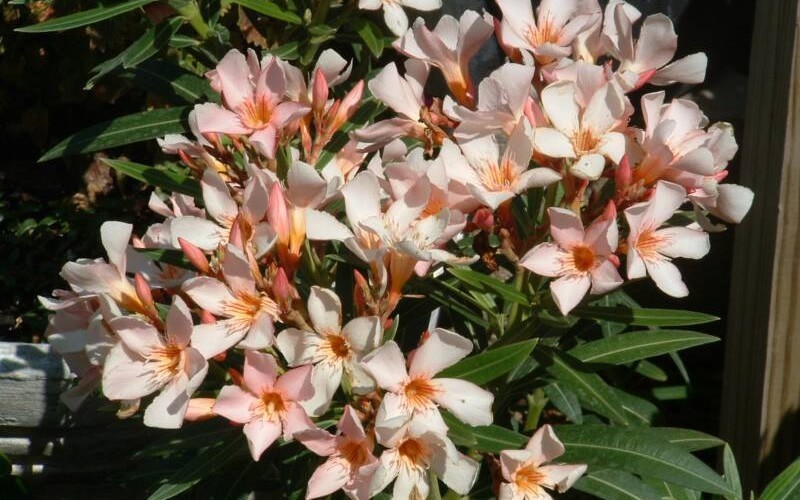
Petite salmon - Mont Blanc - an abundantly flowering bush with white flowers and a rounded shape;
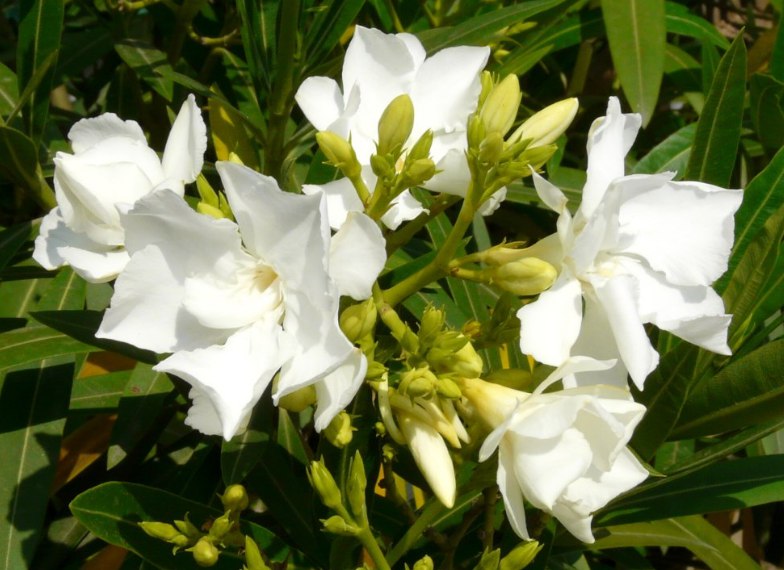
Mont blanc - Cardinal has a fruity aroma, a shade of flowers - raspberry, burgundy;
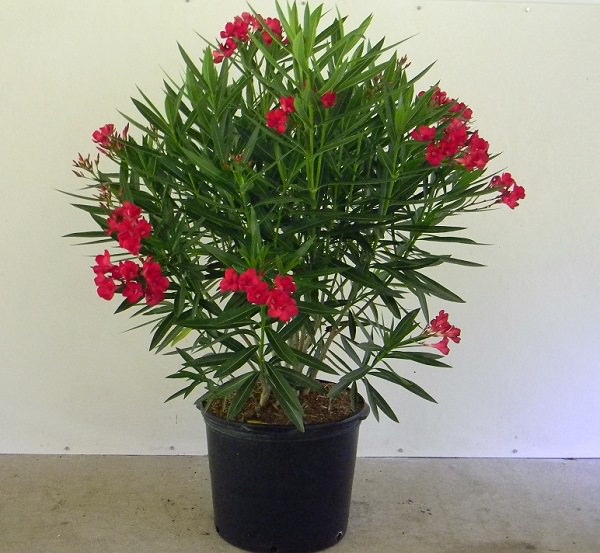
Cardinal - Hardyred with deep red petals, a little terry texture;
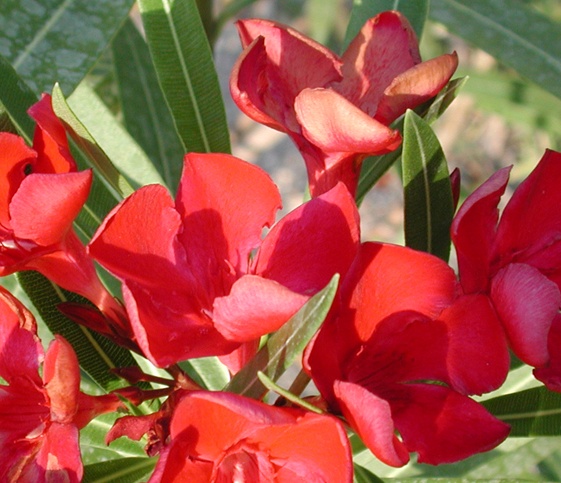
Hardyred - Soleil Levant has pink flowers with yellow centers and a persistent aroma;
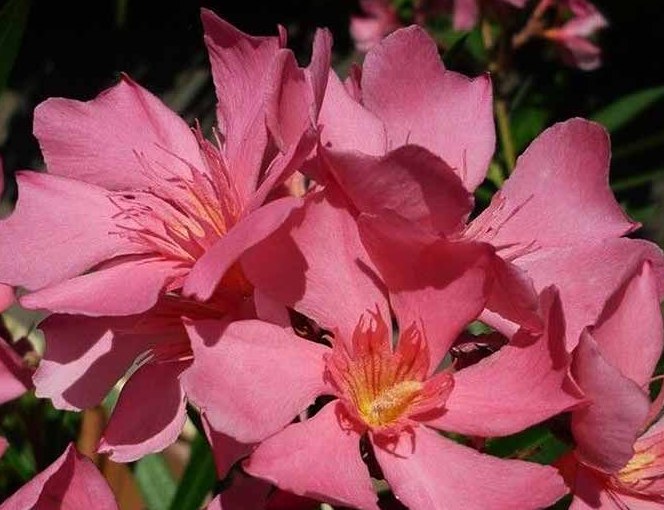
Soleil levant - Variegata is characterized by the presence of terry narrow elongated petals and a rich pink hue;
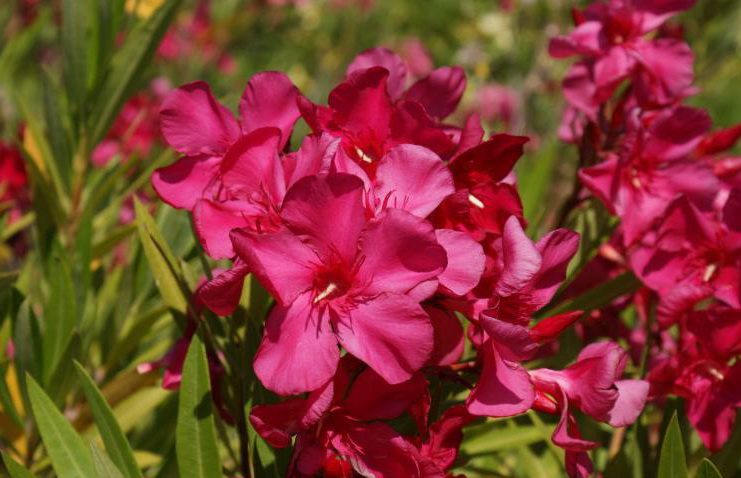
Variegata - Elegance has large flowers in shades of pink to peach, very fragrant.
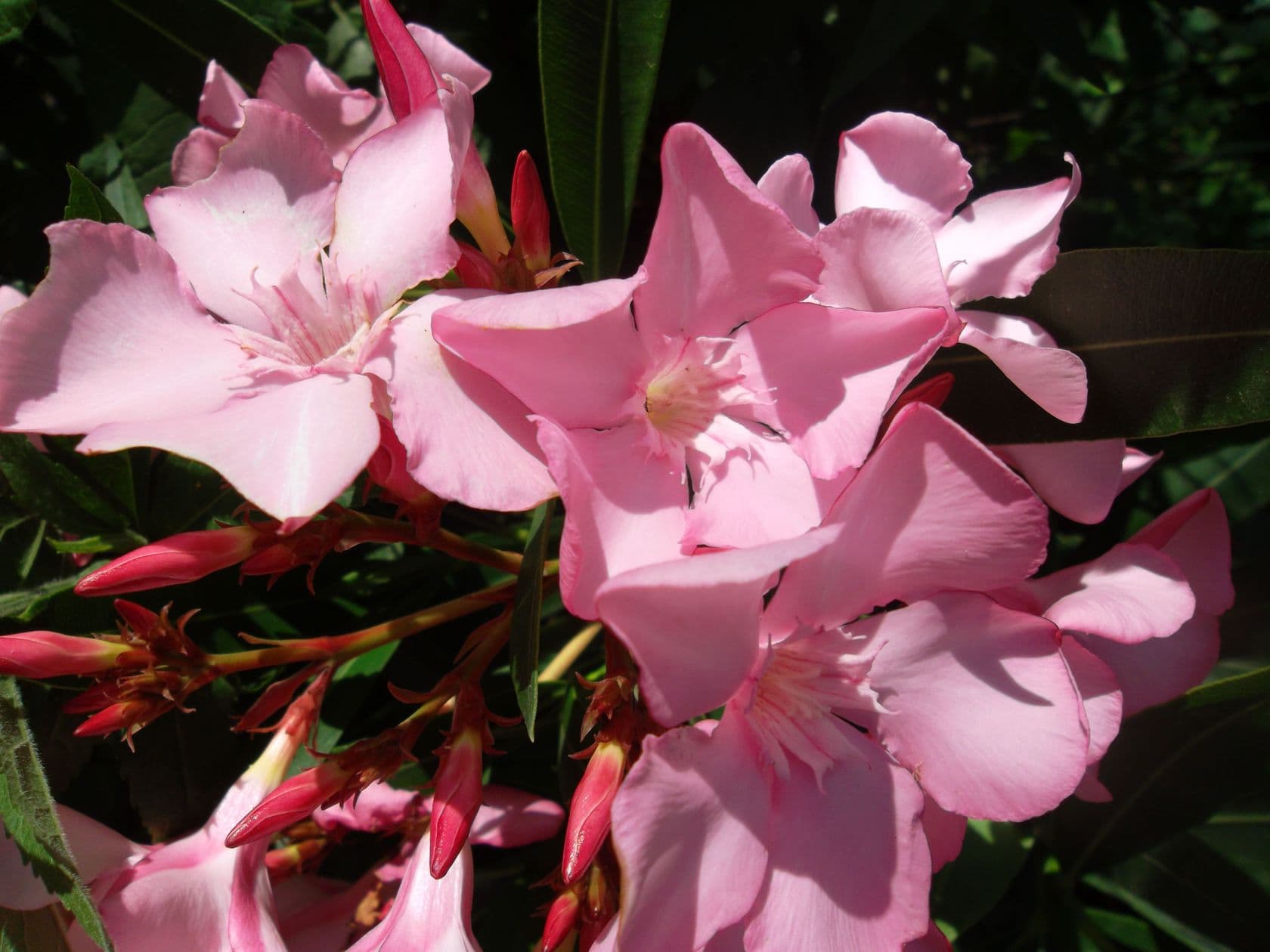
Elegance
Oleander is well suited for growing in gardens and on open terraces, balconies, although the presence of such greenery in the house can also decorate it at any time of the year.
Difficulties in caring for an oleander at home
Despite the fact that the oleander is an exotic plant, growing it at home is not a very time-consuming process, but requires certain conditions for caring for the bush, as well as the availability of free space for it.
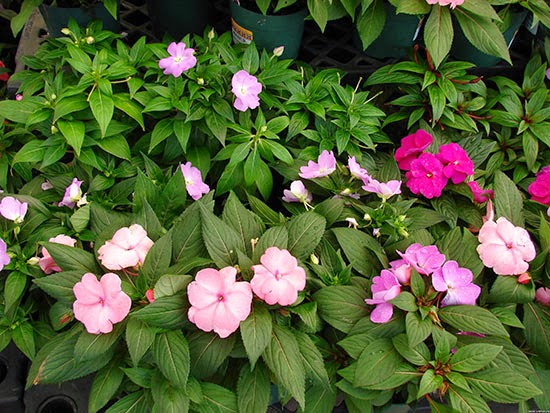 You may be interested in:
You may be interested in:Flowering and its stimulation
Oleander is characterized by lush and rather long flowering, which at home continues from mid-June to late autumn. All this time, new ovaries form in the flower and flowering does not stop.
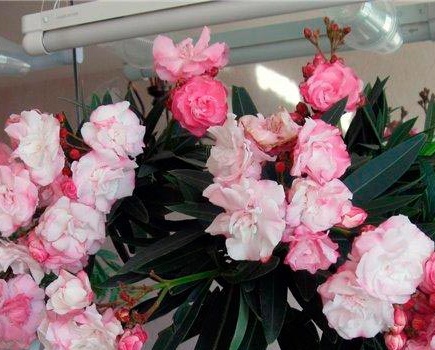
The aroma of a flower during this period is quite strong, therefore it is not recommended to be placed in rooms where children or people prone to allergies are located. This often causes the plant to be dug in the garden during the summer. The flower tolerates such changes very well and after flowering and transplanting back into the pot, it continues to grow, as before.
During the period of active growth of the bush, to stimulate flowering, regular feeding of the plant is required, it should be weekly. You can apply complex and organic fertilizers, it is better to do this 1-2 hours after watering. As a rule, they feed the plant once every three weeks. To do this, you can buy special complex fertilizers. Before top dressing, the soil is well moistened. In the autumn-winter period, it is not necessary to fertilize the oleander.
Landing soil
After acquiring a flower in a store, it is recommended to transplant it into a more suitable substrate. For planting, be sure to use a drainage layer at the bottom of the pot. The soil should consist of equal parts of the mixture of turf land with the addition of humus and peat. A variant of a substrate of humus and clay in equal proportions is also well suited.
When purchasing a substrate in a specialized store, you should give preference to the option for palm trees, it is most suitable for oleander.
Lighting
Oleander is a photophilous flower; for its full development and growth, a lot of light is needed at any time of the year. It is best to grow such a plant on window sills facing the south side. It does not need to be shaded, and in winter time additional lighting should be created with special lamps, especially when the daylight hours are short.
With a lack of light, the plant begins to lose the brightness of the leaves and the buds do not appear or fall off without blooming. In summer, it is ideal to place the oleander on the balcony, where there is a lot of light and fresh air.
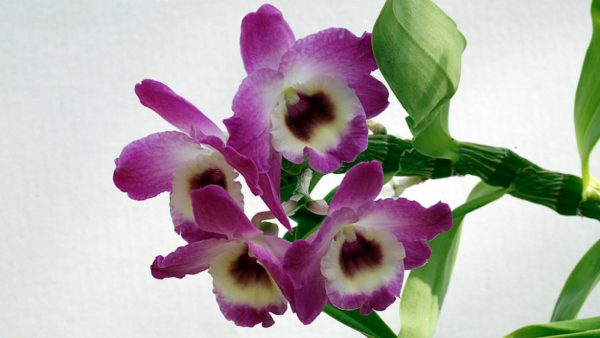 You may be interested in:
You may be interested in:Temperature and humidity
The optimum temperature for a decorative bush in the winter is + 150C, but if it is lower, then nothing bad will happen to the plant, its adaptive capabilities are quite high and even at a temperature of + 100C the flower will not die. In spring and summer, for the comfortable development of the oleander, a temperature of + 22-270C is suitable, it is desirable to have a constant air flow and avoid overheating under the scorching sun.
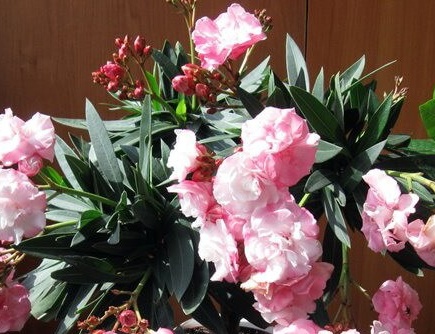
Be sure to spray the foliage in such periods, otherwise the tips of the leaves will begin to curl and dry. In other periods, hydration is not necessary.
Watering
For active growth, the plant needs abundant watering, especially in the heat. If the temperature in the room where the flowerpot stands is lower than + 200С, then it is enough to water 2-3 times a week, focusing on the drying of the top soil layer.
For irrigation, it is advisable to use well-settled water at room temperature or a little warm.Care should be taken to ensure that the pot with the oleander does not stand in the water, since when the soil is poured, the root system begins to rot rather quickly.
Transplant and pruning
A young plant should be transplanted every year in early spring before the start of the growing season, and an adult bush, which is 3-4 years old, requires such a procedure once every several years. At the same time, adult oleanders should be transferred to another container, after having shortened the roots that have already occupied the entire pot. Large bushes do not require a change in capacity, you can simply replace the top layer of soil in which the plant lives with a more nutritious one.
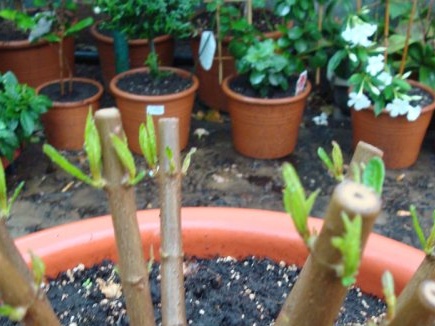
In order to control the size and shape of the crown of the bush, it should be regularly trimmed. The plant not only tolerates this procedure well, but also needs it in order for it to bloom again next year. Pruning to create a form of greenery should be done only after the flowering period has ended.
Branches should be cut in half if necessary, this will not bring any harm to the plant, but will provide an opportunity to sprout new shoots and give a healthier and brighter appearance.
Methods of growing and propagating indoor flower
There are several traditional ways to grow an oleander: by seed, cuttings and aerial layering. You can buy plant elements for planting in specialized stores and greenhouses, and then use the technique that exists for planting a flower.
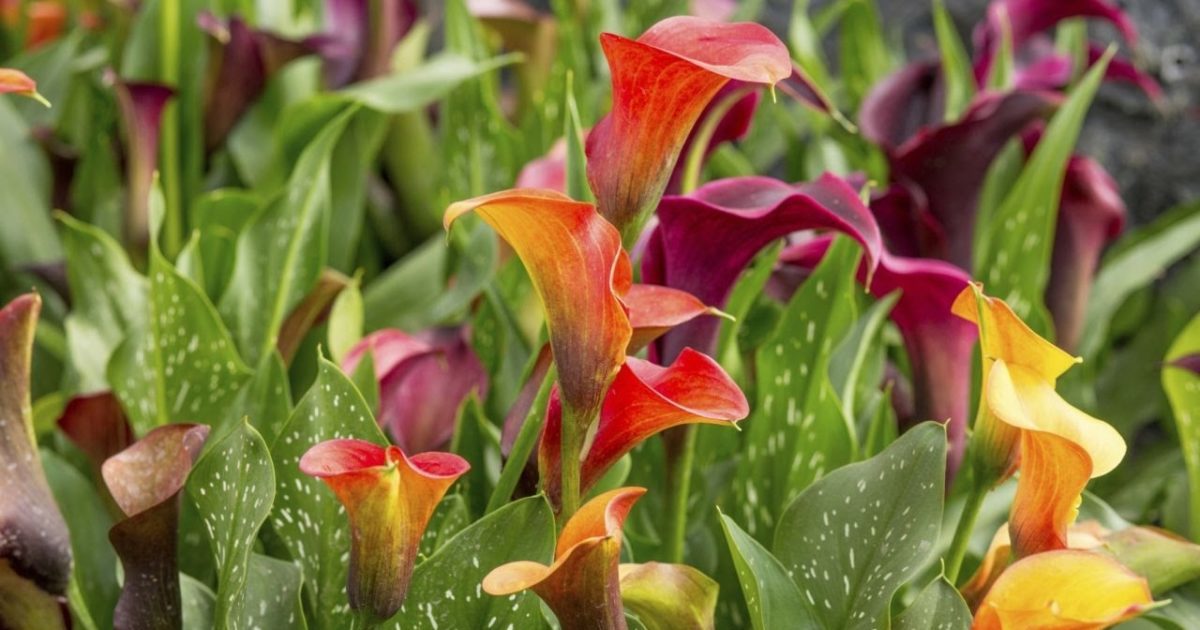 You may be interested in:
You may be interested in:Cuttings
The bush gives young shoots in autumn and spring, they can be used to propagate this flower. The transplantation technique is simple and consists of the following steps:
- Roots are cut off at the root, the preferred length is 10-15 cm.
- Cut cuttings are placed in ordinary cool water until they let the roots out.
- Cut points on the bush should be treated with ash or crushed activated carbon.
- A stem with roots is planted in a pot with a substrate, watered and further fully grows as a new bush.
Since the presence of a large number of young shoots is typical for this plant, it will not be difficult to select some of them for transplantation.
Air layering
This method of reproduction allows you to immediately get a strong plant, which will quickly and actively develop. The use of air layers for growing oleander is as follows:
- a suitable branch of the bush is selected and cuts of the upper layer of the bark are made on it;
- sand is collected in a plastic bag and wrapped around a slice;
- this sand needs to be moistened so that it constantly supplies moisture to the branch;
- after some time, roots will sprout from the incisions;
- the branch is cut from the bush and transplanted into a prepared pot.
This method of breeding an oleander does not require much time and skill, but will allow you to grow a new bush pretty quickly.
Seeds
Perhaps the most time-consuming and unreliable in terms of achieving a positive result is the planting of a room flower using seeds. This is primarily due to the fact that the climatic conditions in the room should be as close as possible to the natural habitat of this species, and this is quite problematic.
Seeds from the store are used for planting, which are usually treated with chemicals to increase their chances of germination. The following steps need to be done:
- Seeds soak them for 50-60 minutes in a growth stimulator.
- In a small box draw a substrate for palm trees and lay the seeds on the surface.
- Cover the container with a transparent film and place it in a warm place, it is desirable that the temperature in it be maintained at + 300С, and there should be enough light.
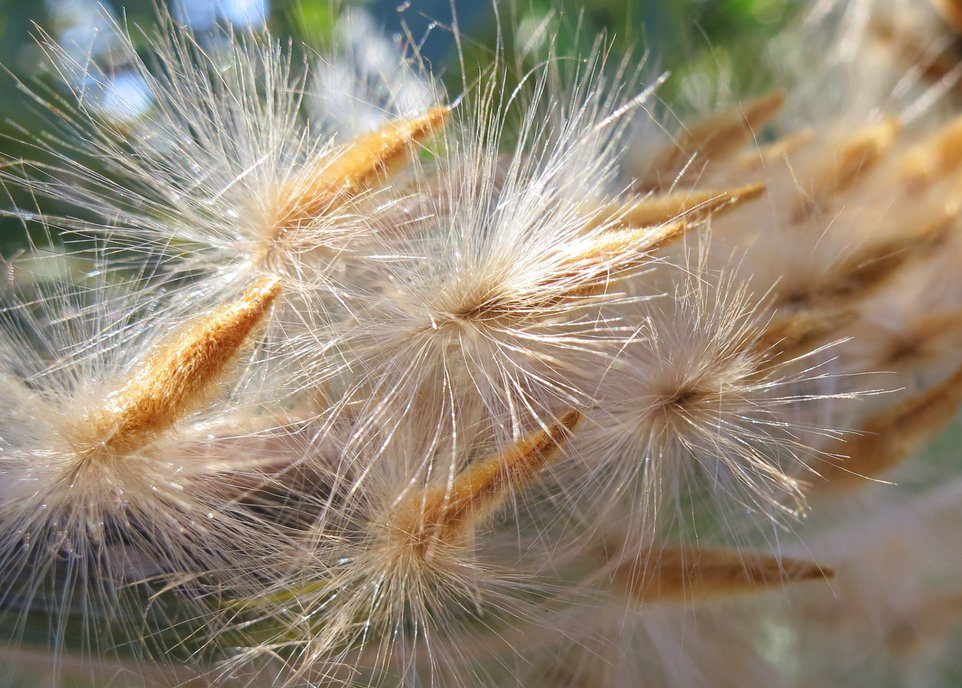
Oleander seeds - Constant soil moisture and airing is required, but without sudden changes in temperature and excess water.
- The film is removed after the first sprouts appear.
- Further watering is reduced, and young shoots germinate until several leaves form on them.
- Ready sprouts are transplanted into a small pot with special soil.
The benefits and harms of oleander
Many people know about the healing capabilities of the oleander, as well as its ability to kill with its poison. When starting this plant, you should know that both hypotheses have long been confirmed, but there are nuances that should be considered when choosing a bush as a decoration for your home or a therapeutic tool.
Poisonous plant or not?
All parts of this plant are poisonous, but the bush is not dangerous if you follow the rules for caring for it. The aroma of flowers can cause dizziness and nausea if the oleander is in a small and poorly ventilated room. You should not put it in a bedroom or a nursery, but it is perfect for large and spacious rooms as an interior decoration.
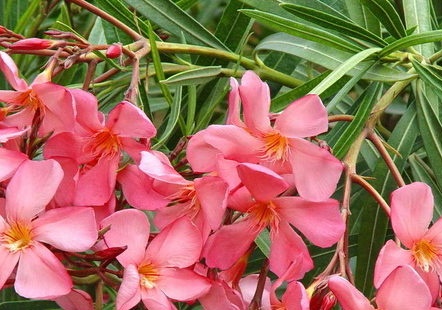
When pruning and transplanting the plant, in order to protect yourself, you need to wear protective equipment, and prevent the juice from getting into open areas of the body. For the same reason, do not plant the bush in houses where there are children and animals who can taste it and thereby endanger themselves. In large quantities, flower poison can cause hallucinations, indigestion, and even heart failure.
Healing properties
The composition of the decorative bush includes such useful components as carobin, saponin, ursulic acid, digitalaline. Their presence allows the use of decorative greens as a component of drugs.
In folk medicine, leaves and dried oleander flowers are used for medicinal purposes:
- ointment from flowers is used in dermatology for insect bites, to reduce itching;
- infusion from the leaves of the plant helps with headaches and toothaches;
- a decoction of flowers is used to treat nervous disorders;
- alcohol tincture is prescribed for muscle pain, diarrhea and vomiting;
- oleander-based solutions are suitable for dilating blood vessels and relieving seizures with regular use.
Common Growing Questions
Oleander is a beautiful plant with fragrant flowers that can decorate the house and garden, creating a special exotic element of greenery. It can also be used for medicinal purposes, but you should be careful with the amount of drugs used, since the plant contains poison, which, if used improperly, can harm human health.

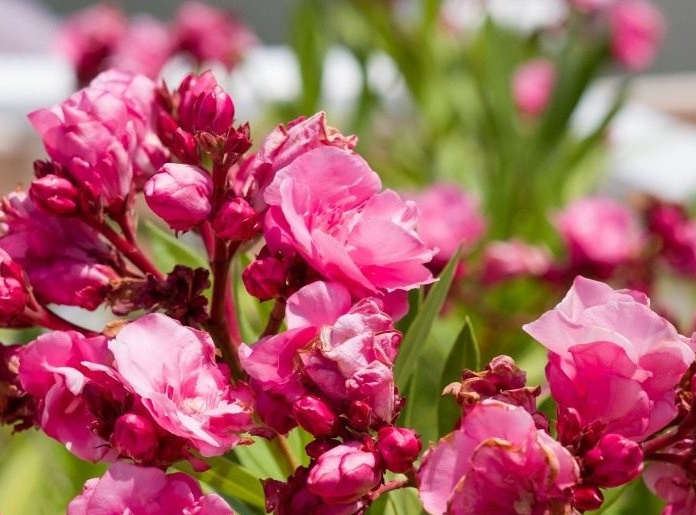
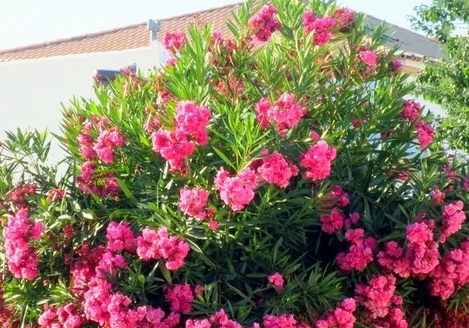
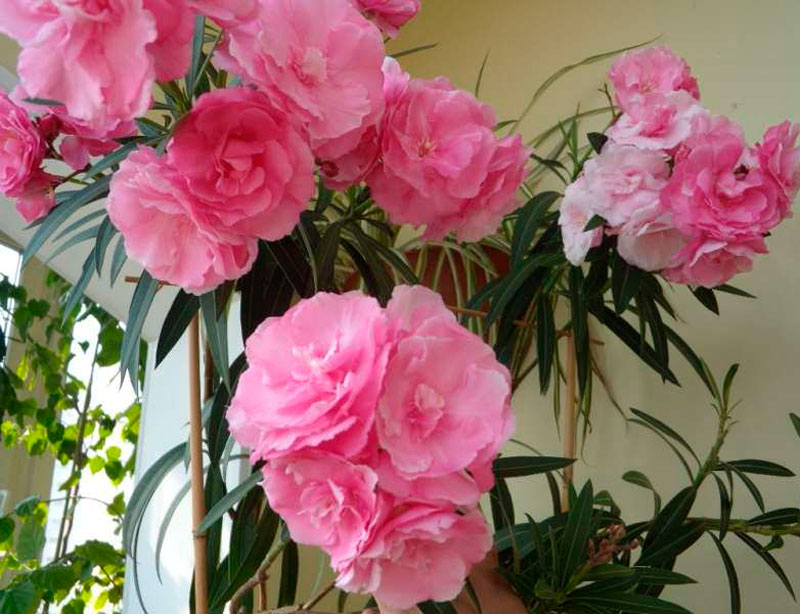
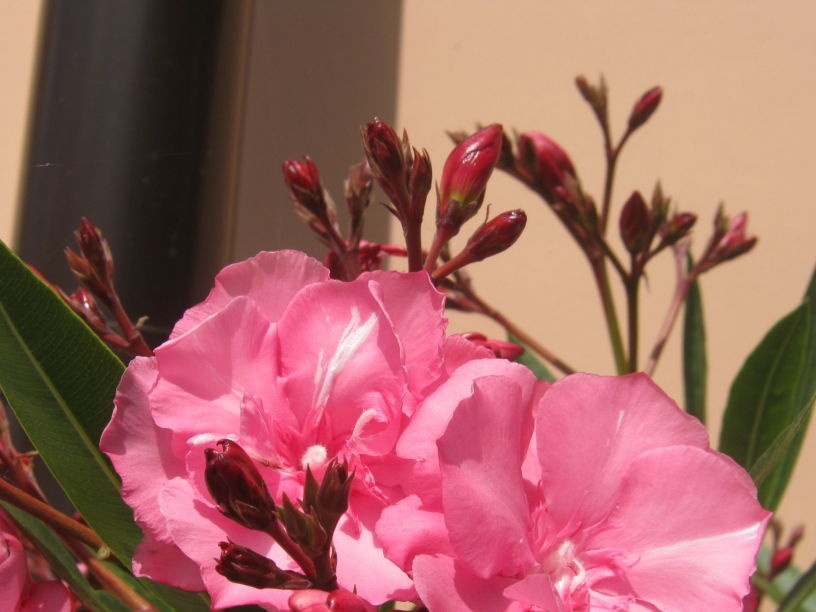
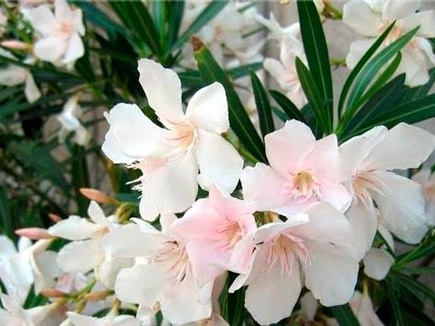
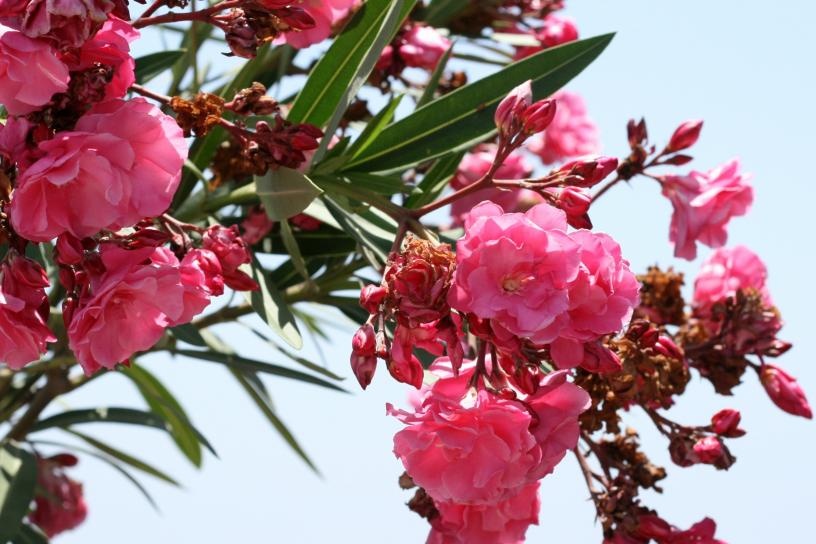
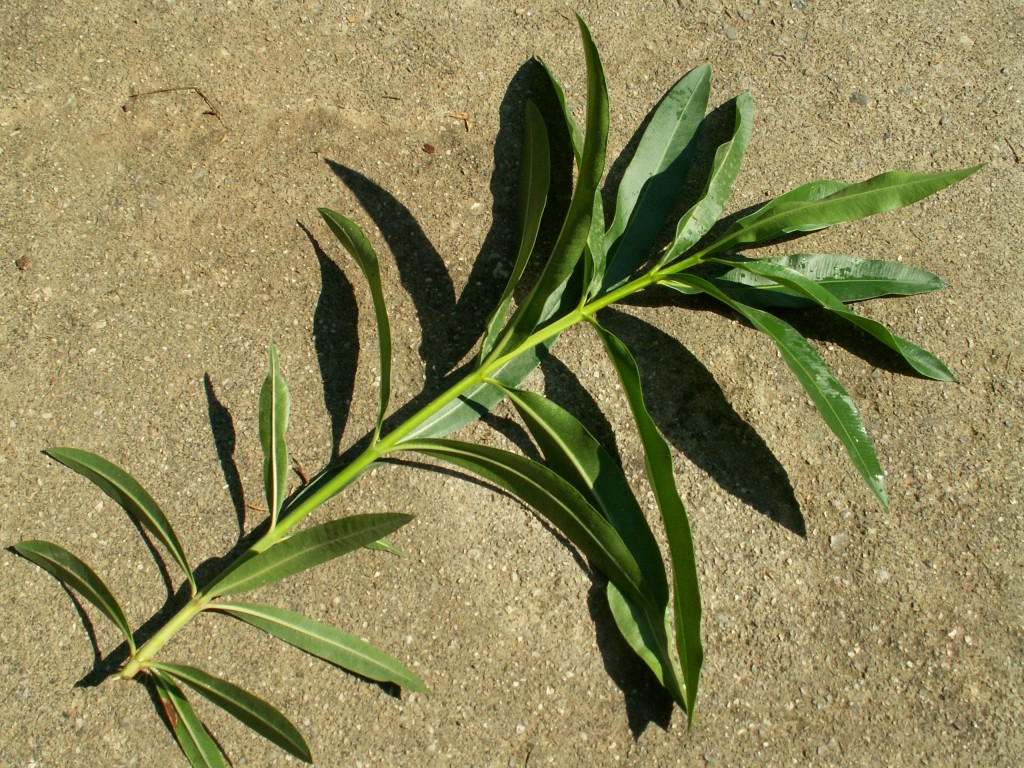
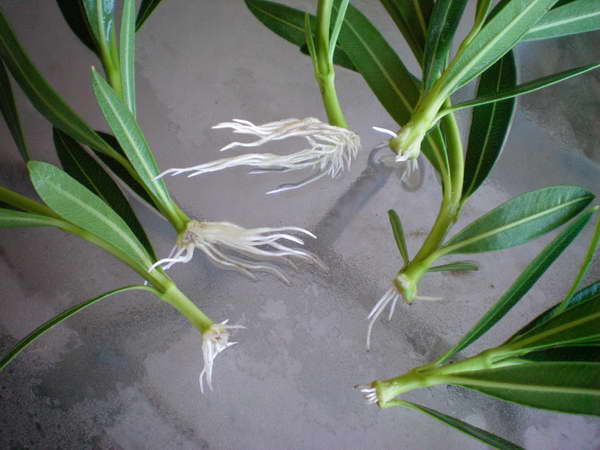




 10 beautiful annuals that bloom all summer
10 beautiful annuals that bloom all summer Sow in the ground, without seedlings: 10 beautiful and unpretentious flowers
Sow in the ground, without seedlings: 10 beautiful and unpretentious flowers Platicodon planting and outdoor care
Platicodon planting and outdoor care Hosta - planting and care in the open ground in the Urals
Hosta - planting and care in the open ground in the Urals